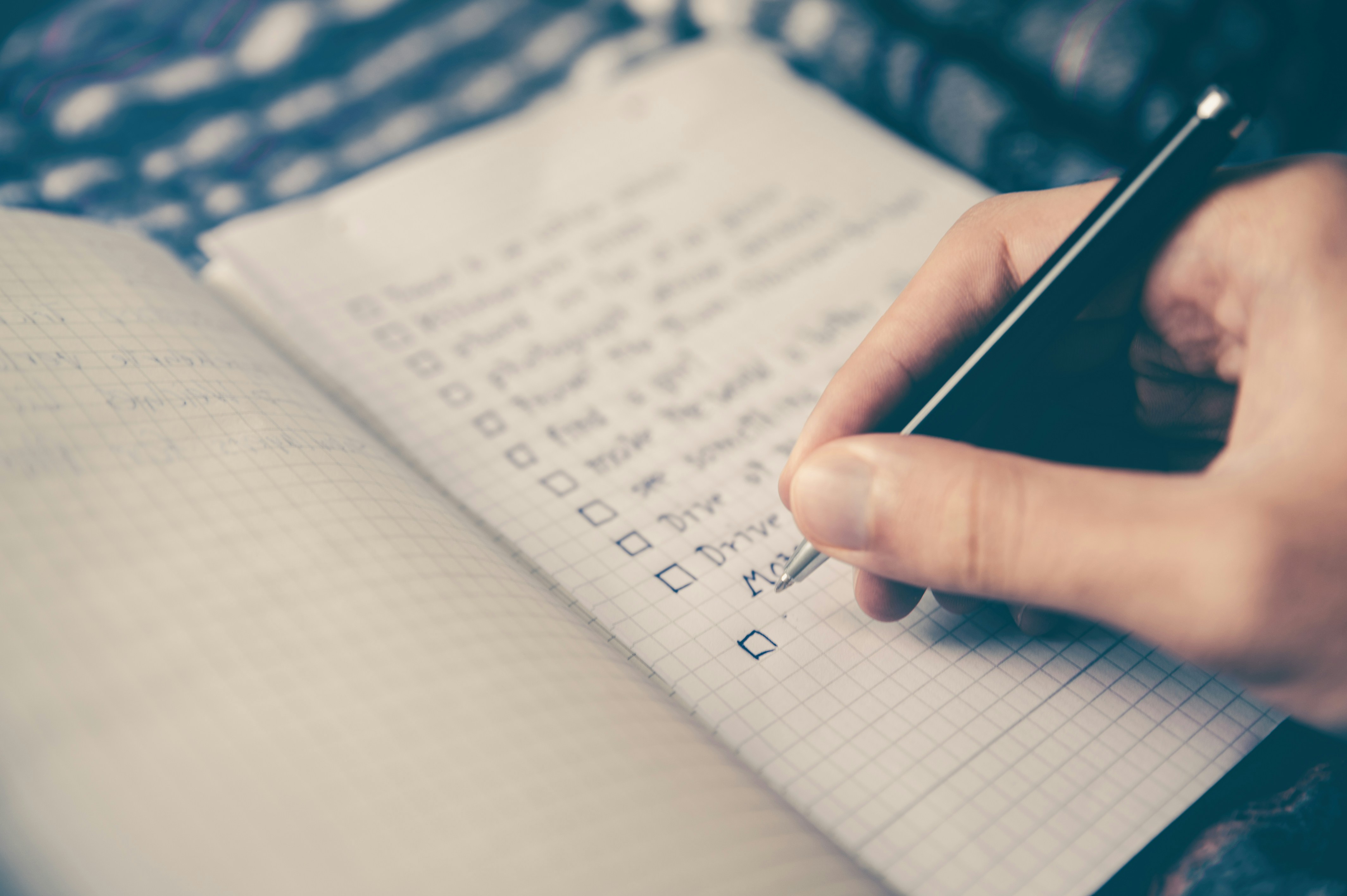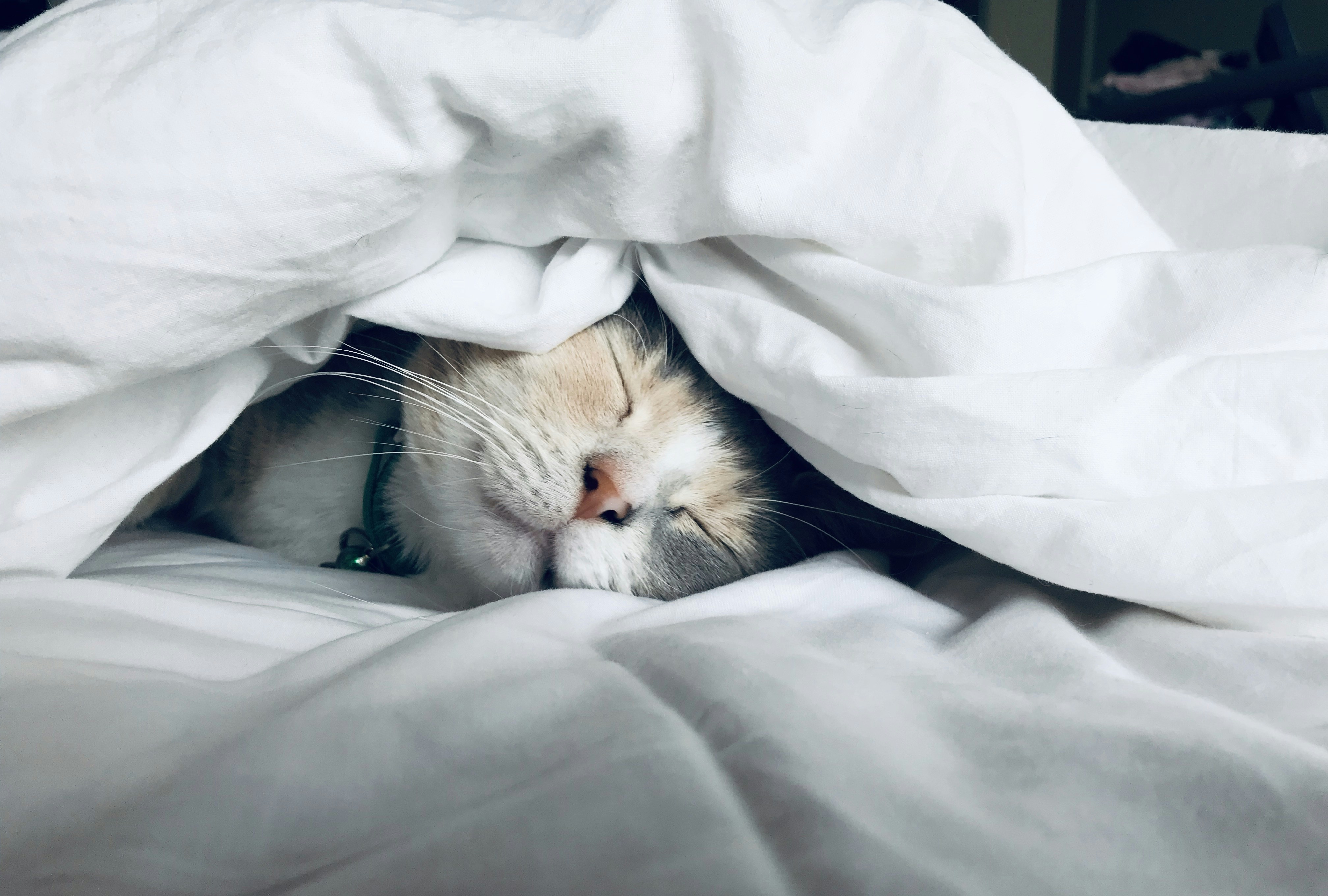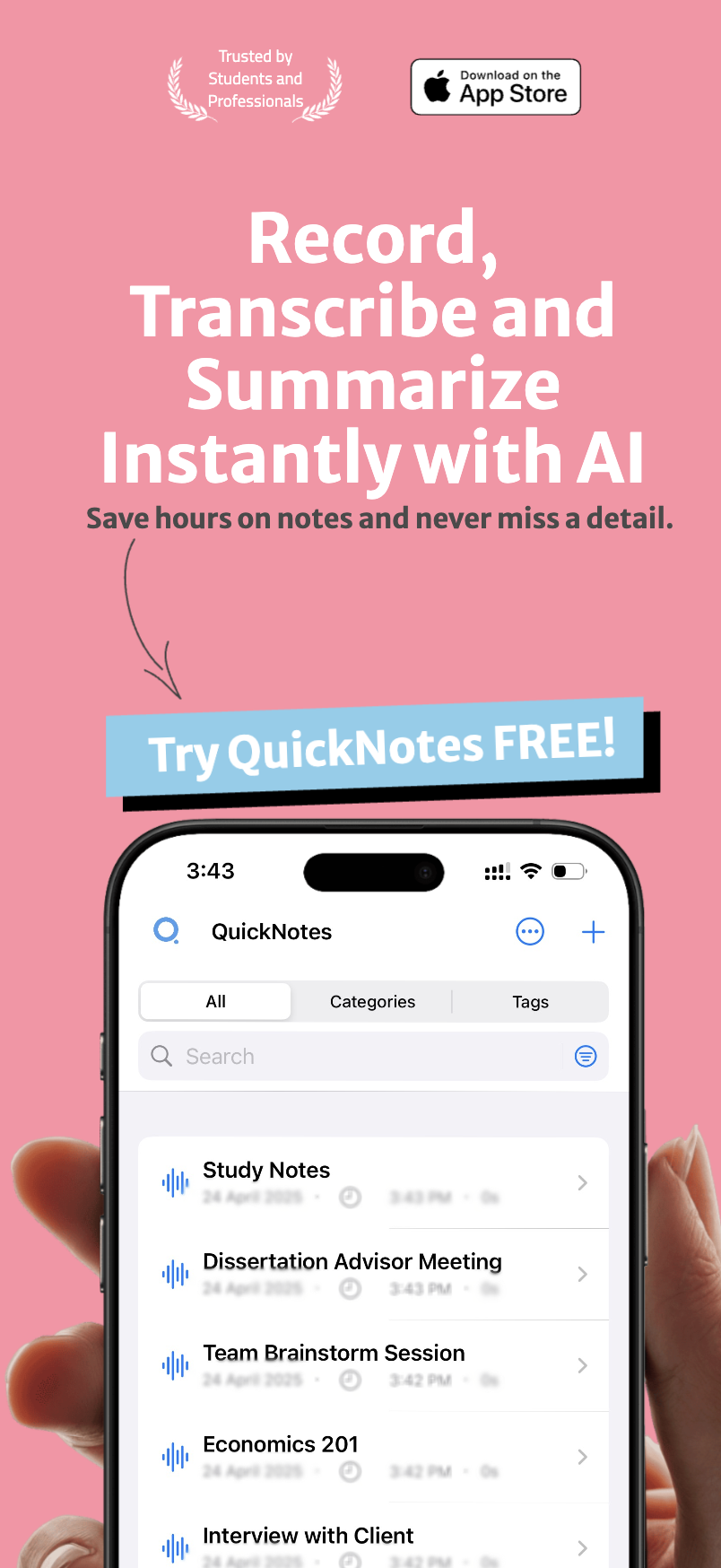If you're a student or professional trying to maximize your learning potential, you've likely experimented with various study techniques, productivity hacks, and note-taking systems. But there's one critical factor that might be undermining all your efforts: sleep. The quality and quantity of your sleep could be the difference between exceptional and mediocre learning outcomes.
Table of Contents
- The Sleep-Learning Connection: What Science Tells Us
- 1. Memory Consolidation
- 2. Synaptic Pruning and Optimization
- 3. Learning Preparation
- The Cost of Sleep Deprivation on Learning
- Attention and Focus Deficits
- Impaired Memory Formation
- Decreased Problem-Solving Ability
- False Memories
- Optimizing Sleep for Enhanced Learning
- 1. Prioritize Sleep Consistency
- 3. Strategic Napping
- How QuickNotes Can Support Your Sleep-Learning Strategy
- 1. Pre-Sleep Review with Audio Features
- 2. Post-Sleep Insights Capture
- 3. Sleep-Optimized Study Planning
- 4. AI-Powered Summaries for Efficient Review
- Practical Sleep-Learning Protocol with QuickNotes
- Evening Routine (60-90 minutes before bed)
- Morning Routine (immediately upon waking)
- Learning Schedule Optimization
- Tracking Your Sleep-Learning Relationship
- Create a Sleep Quality Log
- Tag Learning Sessions by Preceding Sleep Quality
- Experiment with Different Pre-Sleep Review Methods
- Conclusion: The Sleep-Learning Revolution
- You Might Also Like
In this article, we'll explore the fascinating science of sleep and its profound impact on learning and memory. More importantly, we'll discuss practical strategies for optimizing your sleep habits and how tools like QuickNotes can help you leverage this knowledge for better academic and professional performance.
The Sleep-Learning Connection: What Science Tells Us#
Sleep isn't simply a passive state where your brain shuts down. On the contrary, it's a highly active period of processing, restoration, and consolidation. Here's what happens to your learning and memory processes while you sleep:
1. Memory Consolidation#
During sleep, your brain transfers information from short-term memory to long-term memory through a process called consolidation. Research shows that specific sleep stages are particularly crucial for different types of memory:
- Slow-wave sleep (deep sleep) is vital for declarative memory—facts, concepts, and explicit knowledge.
- REM sleep plays a crucial role in procedural memory—skills, habits, and implicit learning.
- Both stages work together to integrate new information with existing knowledge networks.
A groundbreaking study from Harvard Medical School demonstrated that participants who slept after learning a task showed a 20-40% improvement in performance compared to those who stayed awake for the same period.
2. Synaptic Pruning and Optimization#
Sleep also facilitates "synaptic homeostasis"—the process of strengthening important neural connections while pruning away less important ones. This selective reinforcement helps:
- Enhance signal-to-noise ratio in neural networks
- Improve pattern recognition and insight formation
- Create more efficient memory structures
This explains why we often wake up with new insights or solutions to problems we couldn't solve the previous day.
3. Learning Preparation#
Quality sleep doesn't just process what you've learned—it prepares your brain for new learning. After a good night's sleep:
- Your attention and focus improve significantly
- Your brain's ability to form new memories increases
- Your cognitive processing speed accelerates
"Sleep is the single most effective thing we can do to reset our brain and body health each day." — Dr. Matthew Walker, Neuroscientist and Author of "Why We Sleep"
The Cost of Sleep Deprivation on Learning#
Unfortunately, sleep is often the first thing sacrificed during busy academic or professional periods. This trade-off comes with serious consequences:
Attention and Focus Deficits#
Even one night of poor sleep can reduce attention span by 33%. After multiple nights, your ability to focus resembles that of someone legally intoxicated.
Impaired Memory Formation#
Sleep-deprived brains show up to 40% less capacity to make new memories. This means those late-night study sessions may be largely wasted effort.
Decreased Problem-Solving Ability#
Complex thinking, creativity, and insight—all crucial for deep learning—are particularly vulnerable to sleep loss.
False Memories#
Perhaps most concerning, sleep deprivation increases susceptibility to false memories and incorrect associations—exactly what you don't want when studying for exams or learning critical information.
Optimizing Sleep for Enhanced Learning#
Given the crucial role of sleep in learning, how can you optimize your sleep habits? Here are evidence-based strategies:
1. Prioritize Sleep Consistency#
Research shows that regular sleep-wake schedules are even more important than total sleep duration. Aim to:
- Go to bed and wake up at consistent times (even on weekends)
- Align your schedule with your chronotype (morning lark vs. night owl)
- Build buffer zones before bedtime to wind down properly
Small adjustments to your sleeping environment can dramatically improve sleep quality:
- Temperature: Keep your bedroom cool (65-68°F/18-20°C)
- Light: Eliminate blue light exposure before bed and ensure complete darkness during sleep
- Sound: Use white noise or earplugs if needed to block disruptive sounds
- Comfort: Invest in a quality mattress and pillows that support proper alignment
3. Strategic Napping#
When night sleep is insufficient, strategic napping can help:
- Power naps (10-20 minutes): Enhance alertness without grogginess
- Learning naps (60-90 minutes): Include deep sleep for memory consolidation
- Timing matters: Nap before 3pm to avoid disrupting night sleep
How QuickNotes Can Support Your Sleep-Learning Strategy#
While QuickNotes isn't a sleep app per se, several of its features can be strategically used to leverage the sleep-learning connection:
1. Pre-Sleep Review with Audio Features#
Research shows that briefly reviewing key information before sleep improves consolidation during the night. QuickNotes makes this easy with its audio recording and playback capabilities.
According to the QuickNotes Functions documentation, the app provides "high-quality audio recording with a clean, intuitive interface." This allows you to:
- Record short summaries of what you're learning
- Listen to these recordings during your wind-down routine
- Mentally flag important information for your brain to process during sleep
2. Post-Sleep Insights Capture#
Some of your best insights will occur right after waking, when your brain has finished processing information overnight. QuickNotes can help you capture these fleeting insights before they disappear.
The app's speech-to-text capability, which provides "high accuracy using advanced recognition," is perfect for quickly capturing morning insights. Keep your phone by your bed and record thoughts as soon as you wake up, when sleep-processed insights are most accessible.
3. Sleep-Optimized Study Planning#
QuickNotes' organization features can help you structure your learning in ways that leverage sleep's benefits.
The app offers robust "Library Management" features, including "Categories" to "organize recordings by customizable categories" and "Tags" to "apply multiple tags to recordings for flexible organization." Use these features to:
- Tag content that needs review before sleep
- Organize morning insights by category
- Track which learning materials benefit most from sleep processing
4. AI-Powered Summaries for Efficient Review#
When time is limited, QuickNotes' "AI-Powered Summaries" feature can generate "concise summaries from transcribed content" with "adjustable length" options. Use these summaries for efficient pre-sleep review, focusing only on the most important points.
Practical Sleep-Learning Protocol with QuickNotes#
Here's a practical protocol that combines sleep science with QuickNotes features:
Evening Routine (60-90 minutes before bed)#
- Use QuickNotes to record a 2-3 minute summary of the most important concepts you learned that day
- Listen to this recording as part of your wind-down routine
- Mentally phrase specific questions about the material that you'd like clarity on
- Avoid screens for at least 30 minutes before sleep
Morning Routine (immediately upon waking)#
- Keep QuickNotes ready on your phone or tablet by your bed
- As soon as you wake, record any insights, connections, or solutions that emerged overnight
- Use the speech-to-text feature to capture thoughts without even having to open your eyes
- Tag these morning recordings with "sleep insights" for later review
Learning Schedule Optimization#
- Schedule challenging learning tasks earlier in the day when your brain is fresh
- Review this material briefly before sleep
- Plan to revisit complex topics the day after a good night's sleep
- Use QuickNotes' organizational features to track which topics benefit most from sleep consolidation
Tracking Your Sleep-Learning Relationship#
Everyone's optimal sleep patterns are slightly different. To personalize your approach, use QuickNotes to track your sleep-learning relationship:
Create a Sleep Quality Log#
Each morning, record a quick audio note about your sleep quality, duration, and any factors that might have affected it.
Tag Learning Sessions by Preceding Sleep Quality#
Use QuickNotes' tagging system to mark learning sessions based on your prior night's sleep quality. Over time, you'll notice patterns in which sleep characteristics most impact your learning.
Experiment with Different Pre-Sleep Review Methods#
Try various approaches—listening to summaries, recording questions, or reviewing visual materials—and track which leads to the most morning insights.
Conclusion: The Sleep-Learning Revolution#
The science is clear: quality sleep is not a luxury or a sign of laziness—it's a biological necessity for optimal learning and memory. By understanding and leveraging the powerful relationship between sleep and cognitive function, you can dramatically improve your learning efficiency and effectiveness.
QuickNotes provides the perfect companion tools for this approach, allowing you to capture, organize, and review information in ways that work with your brain's natural sleep-based learning processes rather than against them.
So tonight, instead of pulling another late-night study session, try a different approach: review key concepts with QuickNotes, get a full night of quality sleep, and wake up ready to capture the insights your brain has processed overnight. Your memory—and your grades or work performance—will thank you.
You Might Also Like#

AI-Powered Summarization: Extract Key Insights Instantly
Learn how QuickNotes' AI summarization technology helps you extract key insights from lengthy recordings and transcriptions, saving time and improving information retention.

Organization and Tagging: A System for Effective Information Management
Learn how QuickNotes' powerful organization and tagging system helps you categorize, find, and utilize your notes and recordings effectively.

Multi-Language Transcription: Breaking Down Communication Barriers
Discover how QuickNotes' multi-language transcription capabilities can break down communication barriers and streamline global collaboration.

